Do you have a question about the BRP can-am OUTLANDER 2024 and is the answer not in the manual?
Learn how to reduce the risk of accident by reading this Operator's Guide and safety labels before operating the vehicle.
Explains the types of safety messages, their appearance, and how they are used in this guide.
This guide acquaints the owner/operator with vehicle controls, maintenance, and safe operating instructions for proper use.
Covers essential safety measures, including avoiding carbon monoxide poisoning, gasoline fires, and burns from hot parts.
Breathing carbon monoxide can cause headaches, dizziness, drowsiness, nausea, confusion, and eventually death.
Gasoline is highly flammable and explosive; fuel vapors can ignite from a spark or flame many feet away.
Certain components like brake rotors and exhaust become hot during operation; avoid contact to prevent burn wounds.
Modifications or accessories may affect vehicle handling; use BRP-approved parts and avoid unauthorized modifications.
Risk of accident increases if operator lacks proper instruction on vehicle operation and terrain conditions.
Failure to follow age recommendations can lead to severe injury or death, as skills may not match vehicle capabilities.
Passenger must keep feet on footrests and hands on grab handles at all times for stability.
Carrying more than one passenger reduces balance and control, increasing accident risk.
Never allow passengers on front or rear racks; this impairs stability and can cause loss of control.
Tires are for off-road use; paved surfaces affect handling and control, potentially causing loss of control.
Operating on public roads can lead to collisions with other vehicles; this is often illegal.
Wearing approved helmet, eye protection, and protective gear reduces the risk of severe head injury or death.
Using the vehicle with drugs or alcohol impairs judgment, reaction time, balance, and perception, increasing accident risk.
Operating at excessive speeds increases loss of control risk, potentially resulting in an accident.
Attempting stunts like wheelies or jumps increases accident chance, including overturns.
Failure to inspect or properly maintain the vehicle increases accident or equipment damage possibility.
Breaking through ice on waterways can lead to severe injury or death.
Operator and passenger must maintain proper body position for control and balance.
Use extra care on unfamiliar terrain to avoid hidden obstacles and potential loss of control.
Extra care is needed on rough, slippery, or loose terrain to avoid loss of traction and control.
Improper turning can cause loss of control, collision, overturn, or passenger ejection.
Vehicle can overturn more easily on extremely steep hills; never operate on hills too steep for abilities.
Improper hill climbing can cause loss of control, overturn, or passenger ejection.
Improper downhill operation can cause loss of control, overturn, or passenger ejection.
Improper hill crossing or turning can cause loss of control, overturn, or passenger ejection.
Stalling or rolling backward while climbing a hill can result in vehicle overturning.
Improper obstacle operation can cause loss of control, collision, or vehicle overturn.
Improper skidding or sliding can lead to loss of control, overturn, or passenger ejection.
Operating in deep or fast water can cause loss of traction and control, potentially leading to an accident.
Improper reverse operation can lead to hitting obstacles or people, resulting in serious injury.
Improper tire pressure affects handling and control, potentially causing loss of control or tire failure.
Improper modifications can alter handling, potentially causing accidents.
Overloading or improper cargo handling can change vehicle handling, leading to accidents.
Transporting flammable or dangerous materials can lead to explosions and serious injury or death.
Inspect engine oil, coolant, brake fluid, check for leaks, throttle and brake levers, and air filter.
Check digital display for indicator lamps and messages, and inspect operation of lights.
Check ignition switch, engine stop switch, steering, shift lever, brakes, and 2WD/4WD selector operation.
Operator must wear an approved helmet, eye protection, gloves, boots, long-sleeved shirt, and pants for protection.
Vehicle is designed for operator only; never carry passengers on racks or aftermarket seats.
Respect other trail users and designated areas; stay to the right of the trail and be prepared to stop.
Ride responsibly: avoid sensitive areas, do not litter, and respect property.
The vehicle is light and its operation must be restricted to its proper purpose; added weight affects stability and performance.
Off-road operation is inherently dangerous due to unpredictable terrain; utmost care is required.
Increase knowledge and skills via certified training; respect trail signs and drive within visibility and ability limits.
Maintain proper control by keeping hands on handlebars and feet on footpegs at all times.
Ensure visibility on both sides of the road before crossing; drive straight and avoid abrupt changes.
Practice turning at low speeds; keep hands on handlebars, feet on footpegs, and maintain steady speed.
Keep hands on handlebars and feet on footpegs when braking; practice braking response at various speeds.
Check path behind vehicle before reversing; proceed slowly and avoid sharp turns.
Traverse obstacles with caution, avoid large or dangerous ones; approach small obstacles at 90 degrees.
Vehicle has excellent climbing ability but can tip over; be aware of terrain and maintain proper body position.
Keep body weight rearwards, stay seated, apply brakes gradually to prevent skidding.
Risky type of riding; keep body weight on the upside of the slope and be prepared to dismount if vehicle topples.
Avoid drop-offs; vehicle can 'bottom out' or nose dive and tip over.
Check water depth and current before crossing; water should not go above footrests.
Ensure ice is thick and sound enough to support vehicle and load; slow down and avoid rapid braking.
Check for snow/ice accumulations that obstruct visibility or clog openings; reduce speed and allow greater braking distance.
Wet, deep, or fine sand can cause loss of traction; slow down and be watchful of conditions.
Loose stones or gravel affect steering, potentially causing slides or tip-overs, especially at high speeds.
Vehicle assists with light tasks like snow removal, pulling wood, or carrying cargo; use authorized accessories.
Loads affect handling, stability, and braking; do not exceed total load capacity.
Load cargo low and evenly distributed; secure it properly and ensure it does not interfere with controls or visibility.
Never attach loads to the bumper; use only the trailer hitch. Respect maximum hauling capacity.
Towing increases toppling risk, especially on slopes; ensure hitch compatibility and reduce speed.
Vehicle includes hang tags and labels with important safety information; read and understand before riding.
Safety labels are affixed for operator, passenger, and bystander safety; consider them permanent parts.
Improper ATV use can result in SEVERE INJURY or DEATH. Always follow instructions and warnings.
Passenger safety is critical; follow guidelines to reduce risk of severe injury or death.
Improper tire pressure or overloading causes loss of control, potentially leading to severe injury or death.
Never carry passengers on racks; adhere to front and rear load limits.
Operating ATV under 16 increases risk of severe injury or death; never operate if under age 16.
This vehicle is for off-road use only and not intended for public roads.
Locate and note serial numbers for warranty and tracing purposes. VIN is on LH side panel and stamped on front member.
Contains EPA Certification and California Proposition 65 Warning.
Provides Emission Control Information, typically located inside the glove box.
Identifies vehicles complying with EU Regulation (NRMM) on the engine valve cover and frame.
Certifies ATV compliance with ANSI / SVIA-1-2017 standard and an approved ATV Action Plan.
Indicates fuel compatibility with ethanol content, typically located near the fuel cap.
Provides information on Air Filter Maintenance, located on the air box cover.
California models are equipped with an evaporative emission control system for emissions compliance.
Details FCC Part 15 and Industry Canada compliance for the RF D.E.S.S. key security system.
Prohibits tampering with the noise control system, outlining federal and provincial laws.
Provides measured noise emission and vibration values according to Standard EN 15997:2011.
Manufacturer's declaration of conformity with EU directives and regulations.
Manufacturer's declaration of conformity with UK regulations and standards.
Statement regarding Eurasian Conformity mark applicability.
Addresses metal-on-metal sounds under the seat during hard acceleration, possibly indicating engine overexertion.
Troubleshooting steps for when the engine does not turn over, checking stop switch, ignition, D.E.S.S. key, and transmission.
Diagnoses issues when engine turns over but won't start: flooded engine, fuel issues, or ignition problems.
Identifies causes for lack of acceleration: fouled spark plug, fuel starvation, overheating, or clogged air filter.
Addresses overheating issues, suggesting checks for coolant level, radiator fins, and cooling fan functionality.
Troubleshooting engine backfire, potentially caused by exhaust system leaks or ignition timing issues.
Troubleshooting engine misfire, checking spark plug condition and fuel quality.
Diagnoses why the vehicle cannot reach full speed, checking engine issues or brake lock lever engagement.
Addresses issues with a stiff shift lever, possibly due to transmission gear position or CVT condition.
Troubleshooting when engine RPM increases but the vehicle doesn't move: check transmission position, CVT, or water in CVT housing.
Explains reduced power steering assist due to severe steering conditions or CHECK ENGINE/DPS warnings.
Details the limited warranty scope, limitations, exclusions, coverage period, and conditions for USA and Canada.
Covers exhaust and evaporative emission control systems for compliance with EPA regulations.
Details the warranty for evaporative emissions control systems specific to California models.
Provides limited warranty terms for products sold outside USA and Canada, including EEA, Turkey, and CIS countries.
Details warranty terms for products sold in European Economic Area, CIS countries, and Turkey.
Outlines BRP's commitment to privacy, data collection, usage, and disclosure policies.
Provides contact details for BRP offices and customer support worldwide.
Instructions for notifying BRP about address changes or vehicle ownership transfer.
Learn how to reduce the risk of accident by reading this Operator's Guide and safety labels before operating the vehicle.
Explains the types of safety messages, their appearance, and how they are used in this guide.
This guide acquaints the owner/operator with vehicle controls, maintenance, and safe operating instructions for proper use.
Covers essential safety measures, including avoiding carbon monoxide poisoning, gasoline fires, and burns from hot parts.
Breathing carbon monoxide can cause headaches, dizziness, drowsiness, nausea, confusion, and eventually death.
Gasoline is highly flammable and explosive; fuel vapors can ignite from a spark or flame many feet away.
Certain components like brake rotors and exhaust become hot during operation; avoid contact to prevent burn wounds.
Modifications or accessories may affect vehicle handling; use BRP-approved parts and avoid unauthorized modifications.
Risk of accident increases if operator lacks proper instruction on vehicle operation and terrain conditions.
Failure to follow age recommendations can lead to severe injury or death, as skills may not match vehicle capabilities.
Passenger must keep feet on footrests and hands on grab handles at all times for stability.
Carrying more than one passenger reduces balance and control, increasing accident risk.
Never allow passengers on front or rear racks; this impairs stability and can cause loss of control.
Tires are for off-road use; paved surfaces affect handling and control, potentially causing loss of control.
Operating on public roads can lead to collisions with other vehicles; this is often illegal.
Wearing approved helmet, eye protection, and protective gear reduces the risk of severe head injury or death.
Using the vehicle with drugs or alcohol impairs judgment, reaction time, balance, and perception, increasing accident risk.
Operating at excessive speeds increases loss of control risk, potentially resulting in an accident.
Attempting stunts like wheelies or jumps increases accident chance, including overturns.
Failure to inspect or properly maintain the vehicle increases accident or equipment damage possibility.
Breaking through ice on waterways can lead to severe injury or death.
Operator and passenger must maintain proper body position for control and balance.
Use extra care on unfamiliar terrain to avoid hidden obstacles and potential loss of control.
Extra care is needed on rough, slippery, or loose terrain to avoid loss of traction and control.
Improper turning can cause loss of control, collision, overturn, or passenger ejection.
Vehicle can overturn more easily on extremely steep hills; never operate on hills too steep for abilities.
Improper hill climbing can cause loss of control, overturn, or passenger ejection.
Improper downhill operation can cause loss of control, overturn, or passenger ejection.
Improper hill crossing or turning can cause loss of control, overturn, or passenger ejection.
Stalling or rolling backward while climbing a hill can result in vehicle overturning.
Improper obstacle operation can cause loss of control, collision, or vehicle overturn.
Improper skidding or sliding can lead to loss of control, overturn, or passenger ejection.
Operating in deep or fast water can cause loss of traction and control, potentially leading to an accident.
Improper reverse operation can lead to hitting obstacles or people, resulting in serious injury.
Improper tire pressure affects handling and control, potentially causing loss of control or tire failure.
Improper modifications can alter handling, potentially causing accidents.
Overloading or improper cargo handling can change vehicle handling, leading to accidents.
Transporting flammable or dangerous materials can lead to explosions and serious injury or death.
Inspect engine oil, coolant, brake fluid, check for leaks, throttle and brake levers, and air filter.
Check digital display for indicator lamps and messages, and inspect operation of lights.
Check ignition switch, engine stop switch, steering, shift lever, brakes, and 2WD/4WD selector operation.
Operator must wear an approved helmet, eye protection, gloves, boots, long-sleeved shirt, and pants for protection.
Vehicle is designed for operator only; never carry passengers on racks or aftermarket seats.
Respect other trail users and designated areas; stay to the right of the trail and be prepared to stop.
Ride responsibly: avoid sensitive areas, do not litter, and respect property.
The vehicle is light and its operation must be restricted to its proper purpose; added weight affects stability and performance.
Off-road operation is inherently dangerous due to unpredictable terrain; utmost care is required.
Increase knowledge and skills via certified training; respect trail signs and drive within visibility and ability limits.
Maintain proper control by keeping hands on handlebars and feet on footpegs at all times.
Ensure visibility on both sides of the road before crossing; drive straight and avoid abrupt changes.
Practice turning at low speeds; keep hands on handlebars, feet on footpegs, and maintain steady speed.
Keep hands on handlebars and feet on footpegs when braking; practice braking response at various speeds.
Check path behind vehicle before reversing; proceed slowly and avoid sharp turns.
Traverse obstacles with caution, avoid large or dangerous ones; approach small obstacles at 90 degrees.
Vehicle has excellent climbing ability but can tip over; be aware of terrain and maintain proper body position.
Keep body weight rearwards, stay seated, apply brakes gradually to prevent skidding.
Risky type of riding; keep body weight on the upside of the slope and be prepared to dismount if vehicle topples.
Avoid drop-offs; vehicle can 'bottom out' or nose dive and tip over.
Check water depth and current before crossing; water should not go above footrests.
Ensure ice is thick and sound enough to support vehicle and load; slow down and avoid rapid braking.
Check for snow/ice accumulations that obstruct visibility or clog openings; reduce speed and allow greater braking distance.
Wet, deep, or fine sand can cause loss of traction; slow down and be watchful of conditions.
Loose stones or gravel affect steering, potentially causing slides or tip-overs, especially at high speeds.
Vehicle assists with light tasks like snow removal, pulling wood, or carrying cargo; use authorized accessories.
Loads affect handling, stability, and braking; do not exceed total load capacity.
Load cargo low and evenly distributed; secure it properly and ensure it does not interfere with controls or visibility.
Never attach loads to the bumper; use only the trailer hitch. Respect maximum hauling capacity.
Towing increases toppling risk, especially on slopes; ensure hitch compatibility and reduce speed.
Vehicle includes hang tags and labels with important safety information; read and understand before riding.
Safety labels are affixed for operator, passenger, and bystander safety; consider them permanent parts.
Improper ATV use can result in SEVERE INJURY or DEATH. Always follow instructions and warnings.
Passenger safety is critical; follow guidelines to reduce risk of severe injury or death.
Improper tire pressure or overloading causes loss of control, potentially leading to severe injury or death.
Never carry passengers on racks; adhere to front and rear load limits.
Operating ATV under 16 increases risk of severe injury or death; never operate if under age 16.
This vehicle is for off-road use only and not intended for public roads.
Locate and note serial numbers for warranty and tracing purposes. VIN is on LH side panel and stamped on front member.
Contains EPA Certification and California Proposition 65 Warning.
Provides Emission Control Information, typically located inside the glove box.
Identifies vehicles complying with EU Regulation (NRMM) on the engine valve cover and frame.
Certifies ATV compliance with ANSI / SVIA-1-2017 standard and an approved ATV Action Plan.
Indicates fuel compatibility with ethanol content, typically located near the fuel cap.
Provides information on Air Filter Maintenance, located on the air box cover.
California models are equipped with an evaporative emission control system for emissions compliance.
Details FCC Part 15 and Industry Canada compliance for the RF D.E.S.S. key security system.
Prohibits tampering with the noise control system, outlining federal and provincial laws.
Provides measured noise emission and vibration values according to Standard EN 15997:2011.
Manufacturer's declaration of conformity with EU directives and regulations.
Manufacturer's declaration of conformity with UK regulations and standards.
Statement regarding Eurasian Conformity mark applicability.
Addresses metal-on-metal sounds under the seat during hard acceleration, possibly indicating engine overexertion.
Troubleshooting steps for when the engine does not turn over, checking stop switch, ignition, D.E.S.S. key, and transmission.
Diagnoses issues when engine turns over but won't start: flooded engine, fuel issues, or ignition problems.
Identifies causes for lack of acceleration: fouled spark plug, fuel starvation, overheating, or clogged air filter.
Addresses overheating issues, suggesting checks for coolant level, radiator fins, and cooling fan functionality.
Troubleshooting engine backfire, potentially caused by exhaust system leaks or ignition timing issues.
Troubleshooting engine misfire, checking spark plug condition and fuel quality.
Diagnoses why the vehicle cannot reach full speed, checking engine issues or brake lock lever engagement.
Addresses issues with a stiff shift lever, possibly due to transmission gear position or CVT condition.
Troubleshooting when engine RPM increases but the vehicle doesn't move: check transmission position, CVT, or water in CVT housing.
Explains reduced power steering assist due to severe steering conditions or CHECK ENGINE/DPS warnings.
Details the limited warranty scope, limitations, exclusions, coverage period, and conditions for USA and Canada.
Covers exhaust and evaporative emission control systems for compliance with EPA regulations.
Details the warranty for evaporative emissions control systems specific to California models.
Provides limited warranty terms for products sold outside USA and Canada, including EEA, Turkey, and CIS countries.
Details warranty terms for products sold in European Economic Area, CIS countries, and Turkey.
Outlines BRP's commitment to privacy, data collection, usage, and disclosure policies.
Provides contact details for BRP offices and customer support worldwide.
Instructions for notifying BRP about address changes or vehicle ownership transfer.
| Brand | BRP |
|---|---|
| Model | can-am OUTLANDER 2024 |
| Category | Offroad Vehicle |
| Language | English |
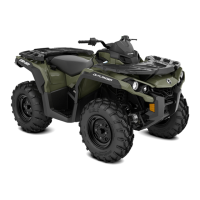
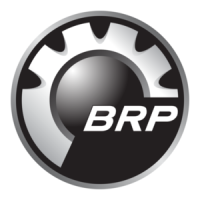

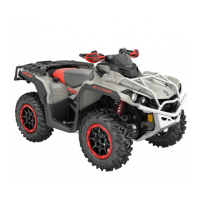


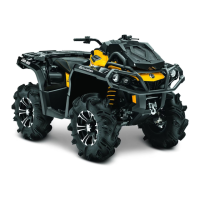

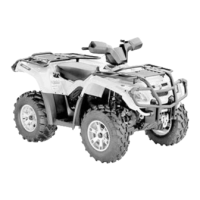
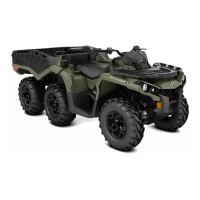

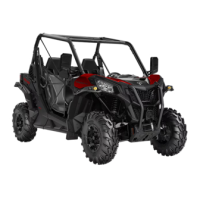
